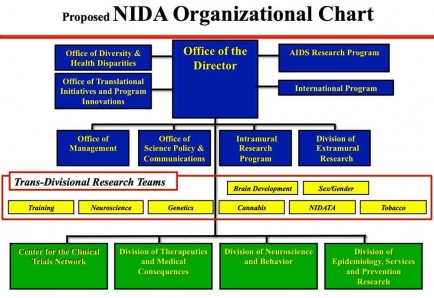NIDA’s Advisory Council periodically reviews the various programs and Divisions within the Institute to ensure they best reflect NIDA’s capacities and mission. At our May 2015 Council meeting, an Advisory Council workgroup presented a series of recommendations (PDF, 1.7MB) related to the scientific areas currently led by the Division of Clinical Neuroscience and Behavioral Research (DCNBR). The workgroup recognized the accomplishments and value of the diverse scientific portfolio and significant achievements of the Division however attrition in staffing led the workgroup to recommend either filling those positions to maintain critical expertise, or spreading the expertise of DCNBR across NIDA by incorporating DCNBR’s portfolio into other existing, modified, and/or new divisions. The latter recommendation was made to better represent NIDA’s current and future research priorities, including the emergence of new scientific areas and translational opportunities.
While NIDA has developed an initial proposal to guide our efforts, to proceed in the wisest possible manner with this reorganization, I am inviting input from the research community and wider public on strategies to strengthen and integrate the scientific areas currently supported by DCNBR throughout the Institute.
DCNBR comprises three branches: the Clinical Neuroscience Branch (CNB), the Behavioral and Brain Development Branch (BBDB), and the Behavioral and Integrative Treatment Development Branch (BITB). Our proposed restructuring would first incorporate the clinical neuroscience, human genetics and developmental neuroscience portfolios that are currently within CNB and BBDB into the Division of Basic Neuroscience and Behavioral Research (DBNBR), to create a new Division of Neuroscience and Behavior (DNB). The current branches within this new DNB will be reorganized (by science and staff) and renamed to reflect the broadened scientific focus of the Division and a more translational approach.
Second, longitudinal cohort studies and genetic epidemiology studies currently managed within DCNBR’s BBDB, as well as studies of how to better bring treatments into real world settings (effectiveness/implementation) from BITB, will be integrated into the Division of Epidemiology, Services, and Prevention Research (DESPR). The Council workgroup also identified brain development as a scientific area critically important to advancing the mission of NIDA in coming years, especially with the imminent implementation of the 10-year ABCD Study. On its recommendation, a new Brain Development workgroup will also be added to NIDA’s existing set of Trans-Division Research Teams.
Lastly, studies related to intervention development and testing and combined medication and behavioral therapies will be integrated into the newly developed Clinical Research Grants Branch within the Division of Therapeutics and Medical Consequences, renamed from the current Division of Pharmacotherapies and Medical Consequences of Drug Abuse to reflect its broadened mission. This integration of research on behavioral interventions with research on other forms of treatment reflects an increasingly mechanistic direction that NIDA has been taking in this area—for instance, thinking of addiction in terms of specific brain circuits and how behavioral, pharmacological, and combined treatments might target them simultaneously to produce improvement. It also better reflects new nondrug treatment approaches currently on the horizon, such as transcranial magnetic stimulation and direct current stimulation.
In addition to the changes to the programs directly managed by DCNBR, a consistent goal has been to enhance collaboration and synergies across different areas of science. This goal will be accomplished through the establishment and strengthening of Trans-Division Research Teams/Workgroups. The purpose of these Teams is to increase the effectiveness of the interdisciplinary collaborations and translational efforts which are essential to maximizing the impact of NIDA science. Topics covered will include the Brain Development workgroup (mentioned above) as well as other workgroups addressing other areas, including big data, tobacco, neuroscience and genetics.
These are some of the ideas we have been considering, but I invite your ideas and input about possible scientific opportunities to be considered with this reorganization.

